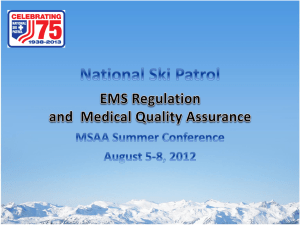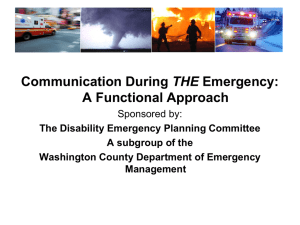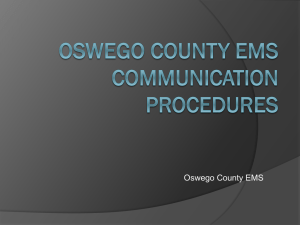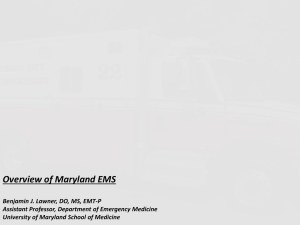LPC-EMS-SFM-Awareness-Training-Module
advertisement
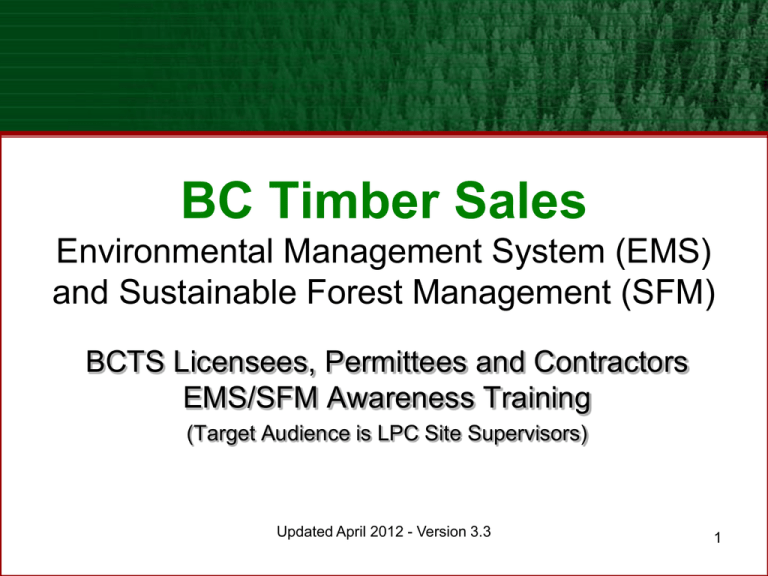
BC Timber Sales Environmental Management System (EMS) and Sustainable Forest Management (SFM) BCTS Licensees, Permittees and Contractors EMS/SFM Awareness Training (Target Audience is LPC Site Supervisors) Updated April 2012 - Version 3.3 1 Purpose of this Training To provide an overview of BCTS EMS Program (Part A). To identify BCTS clients’ key roles and responsibilities and linkages to BCTS EMS program (Part B). Provide overview of Sustainable Forest Management as it applies to BCTS operations (Part C). Updated April 2012 - Version 3.3 2 Part A Overview BCTS EMS Program Acronyms used Why do we need an EMS? How the EMS Works Scope of the EMS Program EMS Certification Key EMS Components Updated April 2012 - Version 3.3 3 Acronyms used in this training BCTS = BC Timber Sales BA = Business Area, i.e.: local BCTS office LPC = Licensee, Permittee or Contractor EMS = Environmental Management System EFP = Environmental Field Procedure BMP= Best Management Practices eERP = environmental Emergency Response Plan SFMP = Sustainable Forest Management Plan Updated April 2012 - Version 3.3 4 Why Do We Need an EMS? • To protect the environment (through a systematic process). • To promote environmental Due Diligence (through training, monitoring, & follow up). • To allow external evaluation of our progress (3rd party audit process). • Mills market their product as certified and coming from sustainably managed forests. Updated April 2012 - Version 3.3 5 How the EMS Works Based on a Principle of Continual Improvement Plan, Do, Check, Respond The Key Steps Project Preparation - Plan Pre-works - Plan Following the Plan - Do Inspecting the Progress - Check Corrective Action - Respond Updated April 2012 - Version 3.3 RESPOND PLAN CHECK DO 6 Scope of BCTS EMS Scope Includes all licenses, permits and contracts awarded by BCTS Timber Sales Managers, as well as all activities undertaken by BCTS staff and LPCs For the following activities: • Planning (i.e. layout, cruising, etc). • Harvesting (i.e. falling, skidding / yarding, processing, loading). • Roads (i.e. subgrade construction, surfacing, bridge/culvert installs, maintenance). • Silviculture (i.e. site prep, planting, surveys). Updated April 2012 - Version 3.3 7 EMS Certification BCTS EMS Program is certified under International Standards Organization ISO 14001 standard. Updated April 2012 - Version 3.3 8 Key EMS Components • Environmental Policy • Field Procedures and local best management practices (EFPs) • Environmental Emergency Response (eERP) • Documentation - Monitoring & Follow up • Awareness and Training Updated April 2012 - Version 3.3 9 Environmental Policy States guiding principles of our certification system Commits to: Meeting applicable laws and regulations. Preventing pollution and protecting environment. Monitoring and evaluating. Continually improving. Communication. Updated April 2012 - Version 3.3 10 Environmental Field Procedures BCTS Field procedures to minimize environmental impacts. Know which ones applies to your job and activity. • EFP 01 “General” -applies to all workers. • EFP 02 “Supervisors” -applies to project and/or onsite supervisor’s. • EFP 03 “Developing & Planning” -applied to planning and development activities. • EFP 04 “Roads Bridges and Major Culverts” -applies to road construction, maintenance inspections and deactivation activities. • EFP 05 “Harvesting” -applies to all phases of harvesting activities. Updated April 2012 - Version 3.3 11 Environmental Field Procedures continued • EFP 06 “Fuel Handling” -applies to fuel handling activities. • EFP 07 “Dryland Sort” -applies to upland dry-land sort activities. • EFP 08 “Marine Log Handling Facilities” - applies to construction , maintenance & operation of log dumps, helicopter water drop zones and direct barge loading facilities. Check with local BCTS representatives for: Any local BMPs or operating procedures Access to copies of EFPs and BMPs. Documents may be posted on local BA websites and/or distributed as field cards or handbooks. Updated April 2012 - Version 3.3 12 Environmental Emergency Response Plan (eERP) Outlines BCTS eERP preparedness and response requirements for the following events: • Forest Fires • Hazardous Spills • Erosion / Landslide Events Updated April 2012 - Version 3.3 13 Records and Documentation Ensure relevant records and documentation is available onsite and current such as: • Project plans (TSL documents, Contracts), site plans, maps etc. • Training records, completed ER Drills. • Emergency Response Plans, MSDS. • Pre-works, Inspections, & Incident Reports. Updated April 2012 - Version 3.3 14 Awareness and Training • All workers and supervisors are required to know their roles and responsibilities as it applies to their activity. This includes; project plans, EFPs, BMPs and eERP etc. • EMS program training requirements for LPC workers and supervisors are outlined in BCTS training matrix. Updated April 2012 - Version 3.3 15 Part B LPC Key Roles & Responsibilities EFP-02 Project Supervision What to Report Worker EMS Tailgate Training Updated April 2012 - Version 3.3 16 EFP-02 Project Supervisors Successful field implementation of BCTS EMS program relies on LPC owner and or supervisors meeting roles & responsibilities outlined in EFP 02 “Project Supervisor”. Updated April 2012 - Version 3.3 17 EFP-02 Project Supervision Supervisors Key Role in EMS: • Attend pre-work held between BCTS representative and Licensee/Contractor. • Ensure all employees, working on the project, are trained as per Table 008-1 LPC Training Matrix. • Provide worker EMS tailgate training to all workers. • Document completed training on LPC Training Summary Table 008 -1A. • Ensure equipment is in good working order (free of leaks, worn hoses) BEFORE bringing it to the worksite. Updated April 2012 - Version 3.3 18 EFP-02 Project Supervision Supervisors Key Role in EMS continued: • Conduct a pre-work with all employees, workers & contractors using BCTS pre-work. Ensure information from BCTS pre-work is relayed to all project workers and sign pre-work form. • Complete eERP before commencement of operations • Review relevant project/site information with employees i.e. maps, prescriptions, field marking, sensitive areas. • Provide workers with copies of maps, plans and EFPs. • Ensure employees understand their roles and responsibilities to complete task. Updated April 2012 - Version 3.3 19 EFP-02 Project Supervision Supervisors Key Role in EMS continued: • Ensure employees are familiar with eERP preparedness and response responsibilities. • Ensure employees understand EMS incident reporting criteria (fires, spills, erosions/landslide events, significant non-conformances & potential non-compliances) see incident report form CHK-009. • Conduct eERP Drill with employees as indicated in the BCTS pre-work. Complete CHK-010 Test-Drill Report, keep on-site copy and forward to BCTS as required. Updated April 2012 - Version 3.3 20 EFP-02 Project Supervision Supervisors Key Role in EMS continued: • Ensure emergency response equipment is available and maintained e.g. Spill kits & fire hand tools. • Conduct operations to minimize impacts on sensitive areas, wildlife habitat, water quality and site productivity. • Ensure fuel tanks and fuel management conforms to fuel handling requirements set out in Fuel Handling Environmental Field Procedure #06 . • Inspect equipment regularly, conduct repairs as required. • Contain all waste daily and remove from site regularly. Updated April 2012 - Version 3.3 21 EFP-02 Project Supervision Supervisors Key Role in EMS continued: • Operate during favourable weather conditions and be aware of project shutdown criteria (e.g. Fire hazard ratings, rainfall shutdown criteria or other operational restrictions). • Conduct inspections at a frequency determined at BCTS pre-work. • Monitor activities to ensure conformance to project plan and EFPs. Updated April 2012 - Version 3.3 22 EFP-02 Project Supervision Supervisors Key Role in EMS continued: • Document inspections on BCTS Self Inspection Report, CHK-011. • Follow-up on any corrective and preventive action(s) identified by pre-works, inspections, incident reports and or results or test/drills have been completed. • Ensure documentation is updated & onsite, (i.e. preworks, inspections, eERP, training summary, test/drill records, MSDS, incident reports). • Be prepared to participate in BCTS certification audits. Updated April 2012 - Version 3.3 23 What to Report Report the following to Supervisor & BCTS: • Hazardous spills, forest fires, erosion/landslide events , significant non-conformances & potential noncompliances. • Any situations that have caused or potential to cause environmental damage. • Previously unidentified resource or cultural features/values, (i.e. Species at Risk, CMTs, Karsts, special sites). • Stop work and changes to project plans. • Safety hazards, close-calls and accidents. Updated April 2012 - Version 3.3 24 Worker Training • LPC personnel who have completed “BCTS LPC EMS/SFM Awareness Training” are responsible for delivering “EMS Tailgate Training” to LPC workers. • Document completed training on LPC Training Summary Table 008 -1A. • Trainers to utilize BCTS “EMS Tailgate Training” field card and applicable EFPs, eERP etc. to promote EMS program awareness. • Worker training to be conducted prior to commencement of operations. Updated April 2012 - Version 3.3 25 Worker Training Workers should be able to demonstrate knowledge of the following: • EMS and SFM policies. • Applicable EFPs, local procedures and shut down criteria. • eERP preparedness & response requirements. • Location of eERP, emergency equipment • What to report. • Project plan and EMS roles and responsibilities. Updated April 2012 - Version 3.3 26 Part C Sustainable Forest Management Sustainable Forest Management (SFM) Certification Impact of SFM Plans Conforming to SFM Plans Updated April 2012 - Version 3.3 27 SFM Certification BCTS has an SFM Policy and has implemented Sustainable Forest Management Plans in operating areas certified under one or more of the following SFM certification standards: • CSA-Z809 – Canadian Standards Association. Canadian National Standard. Internationally endorsed (PEFC). Public Advisory Groups required • SFI – Sustainable Forestry Initiative. North American Standard developed in US but applicable to US and Canada. PEFC endorsed. • FSC – Forest Stewardship Council. International Principles and Criteria with Regional Standards Updated April 2012 - Version 3.3 28 Where SFM Plans have their Impact Influences higher-level planning by introducing its own criteria for forest management. Requires data gathering and reporting to verify adherence to SFM targets: • Can produce changes to operational plans. • Modification of block size and shapes. • Introduction of additional protective measures for resource features/values and sensitive zones. • Changes in road locations and design, etc. Updated April 2012 - Version 3.3 29 How YOU conform to SFM Plans 1. Follow Operational Plans. 2. Follow EMS requirements; • Environmental Field Procedures • Emergency Response Plans (eRPs) • Forms and Checklists • Local Operational Controls and BMP’s • Legislation and Regulations • Training requirements 3. Follow Contract & License requirements. 4. Follow Legislative and Regulatory requirements. Updated April 2012 - Version 3.3 30 Summary BCTS EMS Program supports: Protecting and minimizing impacts on environment Promotes environmental Due Diligence 3rd Party Evaluation BCTS Sustainable Forest Management Market Access Updated April 2012 - Version 3.3 31

